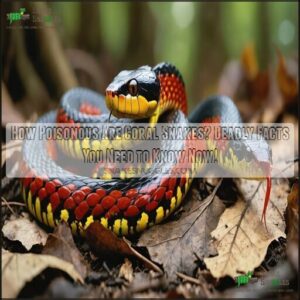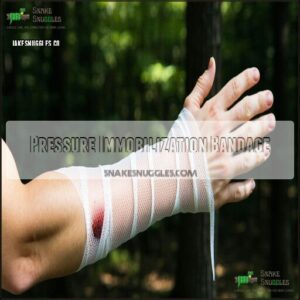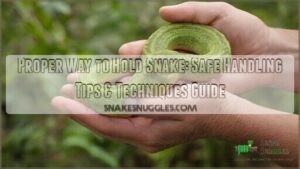This site is supported by our readers. We may earn a commission, at no cost to you, if you purchase through links.
 Coral snakes are highly poisonous, packing one of the most potent venoms of any North American snake.
Coral snakes are highly poisonous, packing one of the most potent venoms of any North American snake.
Their venom is neurotoxic, which means it affects your nervous system and can lead to paralysis or even respiratory failure if untreated.
Surprisingly, bites are rare since coral snakes are shy and prefer to avoid humans.
Symptoms, such as trouble moving muscles or breathing, don’t always show up right away, so getting medical care quickly is essential.
While their bright red, yellow, and black bands are striking, they’re also a helpful warning to treat any coral snake with caution—better safe than sorry, as their venom can be highly potent.
Table Of Contents
- Key Takeaways
- Coral Snake Toxicity Explained
- Recognizing Coral Snake Envenomation
- Treatment Strategies for Coral Snake Bites
- Coral Snake Antivenom: a Lifeline
- Coral Snake Facts and Identification
- Eastern Coral Snake: a Deeper Dive
- Frequently Asked Questions (FAQs)
- How deadly is a coral snake?
- How dangerous are coral snakes?
- Is coral snake is poisonous or not?
- Is a coral snake bite 100% fatal?
- Can you survive a coral snake bite?
- Is a coral snake deadlier than a rattlesnake?
- Why did they stop making coral snake antivenom?
- How lethal is a coral snake?
- How venomous is coral snake?
- How can I tell if a coral snake is venomous?
- Conclusion
Key Takeaways
- Coral snakes are highly venomous snakes, injecting neurotoxins that can paralyze muscles and lead to respiratory failure if untreated.
- Bites are rare since coral snakes are shy, but symptoms like slurred speech and muscle weakness can appear hours later, so seek immediate medical care.
- You can identify venomous coral snakes by their red, yellow, and black bands where red touches yellow, unlike harmless mimics where red touches black.
- Antivenom is critical for treating bites, but it’s scarce, so quick action is essential to counter their deadly effects.
Coral Snake Toxicity Explained
You’ll find that coral snake venom contains powerful neurotoxins that block nerve signals to your muscles, making them different from many other venomous snakes.
Coral snake venom sneaks into your nerves, silencing communication between brain and muscles, leading to paralysis and life-threatening respiratory failure.
These toxins can cause paralysis that starts with slurred speech and blurred vision before potentially affecting your breathing muscles, which is why medical treatment must be sought immediately after a bite.
What Makes Coral Snake Venom Potent
Inside coral snake venom lies a potent cocktail of neurotoxins that make it one of nature’s deadliest substances.
Unlike other snake venoms that destroy tissue, coral snake venom targets your nervous system with surgical precision.
- Alpha-neurotoxins block acetylcholine receptors, preventing nerve signals from reaching muscles
- Phospholipase A2 enzymes break down cell membranes, enhancing venom penetration
- Dendrotoxins disrupt normal nerve function by affecting potassium channels
- Venom components remain stable across temperature variations, ensuring effectiveness
- Coral snake venom requires less quantity than rattlesnake venom to be lethal
This neurotoxic venom’s potency varies between species, with Eastern coral snakes possessing the most dangerous composition in North America.
Neurotoxicity and Respiratory Failure
Coral snake venom’s power lies in its neurotoxins that target your nervous system.
These neurotoxins block acetylcholine receptors, disrupting essential communication between nerves and muscles. The neurotoxic components in snake venom have similar effects.
The venom enzymes methodically shut down your muscle function, leading to muscular paralysis. What makes this particularly dangerous is how it affects your respiratory muscles – your diaphragm and chest muscles struggle to work, potentially causing respiratory failure.
Effect What Happens
Delayed Onset of Symptoms
While respiratory failure marks the critical endpoint of a coral snake bite, the journey there’s marked by deception.
The true danger of a coral snake bite hides in its silent venom, striking hours after the initial encounter.
After a bite, you may experience minimal initial pain, leading many victims to dismiss the encounter. This neurotoxin latency is dangerous – symptoms can remain hidden for 1-12 hours as venom spreads silently.
When neurotoxic venom effects finally appear, they progress rapidly: mild numbness evolves into slurred speech, muscle weakness, and ultimately paralysis. This delayed symptom progression makes missed bites particularly hazardous, as treatment becomes more difficult with each passing hour.
Recognizing Coral Snake Envenomation
You’ll need to watch for symptoms that can appear up to 12 hours after a coral snake bite, including mild pain at the site followed by nausea, slurred speech, and muscle weakness.
Unlike other snake bites, coral snake envenomation often shows minimal swelling or tissue damage but can lead to dangerous respiratory paralysis if not treated promptly.
Mild Pain and Nausea
Unlike rattlesnake encounters, a coral snake bite initially causes only mild discomfort at the wound site.
Within hours, you’ll likely experience nausea, dizziness, and stomach upset – early warning signs of envenomation. These subtle initial symptoms often mislead victims into underestimating the bite’s severity.
The delayed onset of nausea particularly concerns medical professionals, as it signals the neurotoxic venom’s circulation. Don’t wait for symptoms to worsen – immediate medical attention is essential, even if pain seems manageable.
Early treatment dramatically improves survival rates.
Neurotoxicity and Motor Deficits
Unraveling the neurotoxicity of coral snake venom reveals how these bites affect your body’s movement functions.
After envenomation, powerful neurotoxins quickly target your nervous system by blocking acetylcholine, the chemical messenger that controls muscle activation.
This interference creates a descending paralysis that typically starts in your extremities and works inward.
You’ll notice progressive muscle weakness as venom enzymes disrupt nerve signals between your brain and muscles.
Simple movements become increasingly difficult as the neurotoxin potency builds in your system.
Your muscles can’t receive proper instructions on when to contract or relax.
Unlike some venoms that cause tissue damage, coral snake neurotoxic venom works silently by scrambling your nerve communication.
This can progress from mild coordination problems to severe muscular paralysis if left untreated.
Medical intervention is essential, as these symptoms indicate the venom’s dangerous progression toward potential systemic effects, though respiratory failure occurs only in later stages.
Respiratory Muscle Weakness
While motor deficits progress, the most dangerous effect of coral snake venom targets your breathing system.
The neurotoxins directly attack your diaphragm, causing respiratory muscle weakness that can be life-threatening.
- Your chest muscles may struggle to expand properly
- Breathing becomes shallow and difficult
- Diaphragm paralysis can develop within hours
- Ventilation support often becomes necessary
- Aspiration risk increases as throat muscles weaken
Without immediate medical care, these neurotoxin effects can lead to respiratory failure, a primary cause of death from envenomation, which is a highly life-threatening condition.
Close Monitoring for Respiratory Compromise
As muscle weakness progresses, monitoring breathing becomes essential after a coral snake bite.
Watch for these key indicators:
| Monitoring Parameter | Critical Values | Action Required |
|---|---|---|
| Oxygen Saturation | Below 92% | Supplemental oxygen, possible ventilation |
| Respiratory Rate | Under 12 or over 20 breaths/minute | ABG analysis, ventilation support |
| Chest Expansion | Decreased movement | Paralysis monitoring, airway management |
| Speech Clarity | Slurring or difficulty | Neurotoxin progression assessment |
Neurotoxic venom effects can develop slowly over 12 hours, and it is crucial to monitor for respiratory rate and oxygen saturation to ensure timely medical intervention.
Treatment Strategies for Coral Snake Bites
If you’re bitten by a coral snake, you’ll need immediate medical care that includes antivenom administration and respiratory support.
You should keep the bite site below heart level and avoid traditional first aid methods like cutting, sucking, or applying tourniquets that can make the situation worse, as this requires respiratory support.
General Treatment Measures
Now that you know the signs of coral snake envenomation, taking the right first aid steps is essential.
If bitten by a coral snake, your immediate actions matter:
- Remove jewelry and tight clothing near the bite
- Clean the wound gently with soap and water
- Keep the bite area below heart level
- Remain calm and still to slow venom spread
Call 911 immediately—hospital supportive therapy and antivenom treatment are essential. It’s important to follow the antivenom administration guidelines for proper care.
Pressure Immobilization Bandage
When treating a coral snake bite, pressure immobilization bandages can substantially slow venom spread through your lymphatic system. Apply these specialized wraps immediately while seeking emergency medical care.
A suitable bandage is available for purchase online.
| Bandage Type | Application Technique | Effectiveness |
|---|---|---|
| Elastic Wrap | Wrap firmly from bite toward heart | High |
| Crepe Bandage | Apply with constant pressure | Medium |
| Commercial Snake Kit | Follow package instructions | Variable |
Aim for firm pressure that restricts lymph flow but doesn’t cut off blood circulation. Immobilize the limb with a splint after bandaging.
Don’t cut, suck, or apply ice to the bite area, and remember to use pressure immobilization bandages to slow venom spread, which is a critical step in treating the bite, and always seek emergency medical care.
Antivenom Administration
After applying a pressure bandage, antivenom becomes your critical next step against coral snake envenomation.
NACSA (North American Coral Snake Antivenin) works by neutralizing the venom’s neurotoxic effects.
When receiving antivenom treatment, administration occurs within 30 minutes of the bite for best results.
Dosage depends on symptom severity and patient weight.
The following steps are crucial during treatment:
- Administration occurs within 30 minutes of the bite for best results
- Dosage depends on symptom severity and patient weight
- Medical professionals monitor for allergic reactions during treatment
- Multiple doses may be needed over several hours
- Hospital stays typically last 24-48 hours for observation
Horse-derived antivenom carries potential for allergic reactions but remains the most effective treatment for coral snake bites.
You can find products for snakebites online.
Anticholinesterases serve as an alternative when antivenom isn’t available.
Close Observation for 24 Hours
After antivenom is given, you’ll need close monitoring for at least 24 hours. This observation period is critical since coral snake bite symptoms often develop slowly, sometimes appearing 12 hours after the bite.
0-6 hours
6-12 hours
12-24 hours
Medical supervision during this window focuses on detecting early signs of paralysis. Healthcare staff will regularly check your muscle strength, speech patterns, and breathing rate. They’re watching for delayed reactions to neurotoxins that could affect your respiratory muscles.
**Initial symptoms include sharp pain sensations.
** Don’t be surprised by frequent neurological exams. This intensive symptom monitoring gives doctors time to respond quickly if envenomation progresses, preventing serious complications from developing.
Coral Snake Antivenom: a Lifeline
You’ll need coral snake antivenom within 12 hours of a bite to block the deadly neurotoxins that can stop your breathing.
This lifesaving treatment consists of purified antibodies that attach to the venom molecules, preventing them from causing paralysis and respiratory failure.
North American Coral Snake Antivenin (NACSA)
The North American Coral Snake Antivenin (NACSA) serves as a critical lifeline for victims of coral snake bites.
This horse-derived immunoglobulin specifically targets venom from Micrurus fulvius and other coral snake species.
While NACSA effectiveness remains high, antivenin availability has become increasingly limited.
Medical facilities in regions with coral snake populations maintain strict administration protocols to guarantee this precious resource is used appropriately when treating the rare but potentially deadly bites.
Understanding the venom’s 3FTx components is vital for effective antivenom development.
Administration and Controversies
Beyond the antivenin itself, several controversies swirl around coral snake bite treatment.
Medical professionals must weigh these key factors:
- Antivenom shortages limit availability in many regions
- Treatment costs can exceed $30,000 per patient
- Research funding gaps slow development of better options
The venom’s neurotoxin potency varies by species, complicating treatment protocols.
Public education remains essential, as many don’t understand the significant difference between venom injection methods and their potential consequences, which can lead to significant treatment costs.
Anticholinesterases as Alternative
While NACSA supplies remain limited, anticholinesterases like neostigmine offer a valuable backup plan.
These medications work by stopping the breakdown of acetylcholine, helping your nerves function despite coral snake neurotoxins.
Research shows they’re effective at countering venom toxicity by maintaining nerve impulses when breathing muscles are threatened.
Though side effects can include excess secretions and muscle cramps, their accessibility makes them important tools when antivenom isn’t available.
Future research continues to refine these life-saving treatments.
Coral Snake Facts and Identification
You’ll need to know how to spot a coral snake’s distinct red, yellow, and black banding pattern to stay safe in their habitat.
Their black heads and rings that completely circle the body are key features that separate these venomous elapids from harmless lookalikes.
Elapidae Family and Species
The Elapidae family’s elegant members include coral snakes, which belong to this venomous clan.
When exploring North American wilderness, you might encounter three distinct coral snake species:
- Eastern coral snake (Micrurus fulvius) – known for powerful neurotoxins
- Texas coral snake (Micrurus tener) – recognized by its distinctive banding
- Sonoran coral snake (Micruroides euryxanthus) – smallest of the three species
These snakes share the Elapidae family characteristics with cobras and sea snakes worldwide.
Red, Yellow, and Black Bands
The striking red, yellow, and black bands of coral snakes aren’t just beautiful—they’re nature’s warning signs.
These distinctive patterns evolved as a clear signal: "stay away". You’ll notice the specific arrangement where red and yellow rings touch each other directly, unlike copycat species with different arrangements.
| Feature | Coral Snake | Mimic Species |
|---|---|---|
| Pattern | Red touches yellow | Red touches black |
| Band width | Even rings | Varied widths |
| Color intensity | Bright, vivid | Often duller |
| Complete rings | Fully encircle body | May be incomplete |
| Regional variations | Slight color differences | Significant differences |
The distinctive patterns and specific arrangements serve as a warning to potential threats, highlighting the importance of understanding these visual cues to distinguish between coral snakes and mimic species.
Mnemonic for Differentiation
When you encounter a snake with colorful bands, a time-tested rhyme could save your life: "Red touch yellow, kills a fellow; red touch black, venom lack." This simple mnemonic helps distinguish deadly coral snakes from harmless lookalikes like the scarlet king snake.
The rhyme’s reliability varies by region, working best for North American species. In other regions, different color patterns may apply, creating accuracy concerns among herpetologists.
- Pattern Recognition: Venomous coral snakes have red and yellow rings touching, while non-venomous mimics have red rings bordered by black.
- Head Assessment: Coral snakes have black, blunt heads, while mimics typically display red heads with pointed snouts.
If you can’t remember the rhyme or spot the pattern clearly, maintain a safe distance and contact wildlife professionals.
Habitat and Behavior
Coral snakes glide silently through the shadows of southeastern woodlands, their vibrant bands hidden beneath forest debris.
These elusive reptiles prefer specific habitats and exhibit distinct behaviors.
| Habitat Feature | Behavioral Trait |
|---|---|
| Wooded areas | Nocturnal activity |
| Marshy regions | Burrowing habits |
| Leaf litter | Avoids confrontation |
| Suburban edges | Retreats when threatened |
You’ll rarely spot these venomous snakes during daylight hours. They’re masters of concealment, spending most of their time underground or beneath fallen leaves.
Their geographic distribution spans from Florida through parts of Texas and into Mexico. To properly identify them, remember that red touches yellow on a coral snake.
During suburban encounters, coral snakes employ defensive mechanisms like hiding rather than striking. Unlike aggressive species, they’d rather slip away unnoticed than confront potential threats, and they will retreat when threatened. Coral snakes are also known for their ability to avoid confrontation and their nocturnal activity. They are elusive reptiles that prefer to hide, making them difficult to spot.
Eastern Coral Snake: a Deeper Dive
You’ll find the Eastern coral snake to be one of North America’s most venomous reptiles, with neurotoxic venom that’s more potent than a rattlesnake’s.
Its distinctive red, yellow, and black bands serve as a warning sign that you shouldn’t ignore if you encounter this shy but dangerous snake in southeastern woodlands.
Appearance and Identification
The Eastern coral snake’s appearance demands your attention with its striking tri-color pattern.
When identifying this venomous serpent, focus on these four critical features:
- Color Patterns: Red and yellow rings touch each other (remember: "red touches yellow, kills a fellow"), unlike harmless lookalikes where red touches black.
- Head Shape: Look for a blunt, black head that’s barely wider than the neck—unlike many venomous snakes that have triangular heads.
- Ring Completeness: Notice how the bright bands completely encircle the body, unlike mimics whose patterns may not extend fully around.
- Size Variation: Adults typically measure 18-30 inches long, with a pencil-thin diameter.
These coral snake identification markers help distinguish this dangerous Elapidae family member from harmless mimics.
Venom and Effects
The venom of Eastern coral snakes works like a silent saboteur in your nervous system.
This potent neurotoxin disrupts nerve signals to muscles, causing weakness that progresses to paralysis.
Unlike rattlesnake bites, symptoms appear gradually – sometimes taking 12 hours to develop.
Watch for slurred speech, double vision, and breathing difficulties.
Though bite marks may be minimal, the venom’s delayed effects can lead to respiratory failure and cardiac arrest if left untreated.
Life Cycle and Reproduction
The fascinating reproduction of coral snakes showcases their unique survival strategy.
In their snake taxonomy, they’re premier planners. Here’s how:
- Mating habits guarantee genetic diversity.
- Females lay 3-12 eggs in secluded, moist spots.
- Eggs incubate for weeks, producing hatchlings 7 inches long.
- Hatchlings possess fully functional juvenile venom.
- Growth rates rapidly transform them into adult predators.
Snake reproduction guarantees survival efficiency!
Conservation Status
Habitat loss and climate change threaten many snake species, but coral snakes show surprising resilience.
While some populations face challenges, conservation efforts, like protected areas and education, help maintain balance. These snakes play a key role in ecosystems, controlling pests and supporting biodiversity.
Here’s how conservation looks for coral snakes:
| Factor | Impact on Populations | Efforts to Protect |
|---|---|---|
| Habitat Loss | Declining habitats | State/National Parks |
| Climate Change | Shifting ranges | Research/Monitoring |
| Urban Expansion | Population fragmentation | Public Education |
| Illegal Pet Trade | Risk to species | Legal Protection |
| Ecosystem Role | Balanced biodiversity | Habitat Protections |
Protecting coral snake habitats guarantees their survival and ecosystem health.
Frequently Asked Questions (FAQs)
How deadly is a coral snake?
Coral snakes are highly venomous, delivering potent neurotoxins that can paralyze muscles and cause respiratory failure.
While bites are rare and symptoms may be delayed, their venom is dangerous enough to potentially threaten a person’s life.
How dangerous are coral snakes?
Coral snakes are highly dangerous due to their potent neurotoxic venom, which can cause paralysis and respiratory failure.
While bites are rare, their unique chewing action injects enough venom to threaten human life.
Is coral snake is poisonous or not?
Imagine holding a loaded dart—coral snakes aren’t poisonous; they’re venomous.
Their bite delivers potent neurotoxins that harm your nervous system, but they’re shy and usually avoid humans unless provoked.
Best approach: don’t touch them, as this will help prevent any potential harm.
Is a coral snake bite 100% fatal?
A coral snake bite isn’t 100% fatal, but it’s dangerous without treatment.
Their venom contains neurotoxins that can cause paralysis or respiratory failure.
Immediate medical attention and antivenom are critical to reduce serious risks.
Can you survive a coral snake bite?
Surviving a coral snake bite is possible, but quick medical attention is critical.
Their venom is highly toxic, causing paralysis and respiratory failure.
Luckily, bites are rare and often deliver little venom, buying you precious time.
Is a coral snake deadlier than a rattlesnake?
A rattlesnake is generally deadlier due to its hemotoxic venom causing immediate tissue damage and swelling.
While a coral snake’s neurotoxic venom works slower, targeting nerves and muscles.
Both bites need quick medical help.
Why did they stop making coral snake antivenom?
Only 100 coral snake bites are reported annually, making demand for antivenom rare.
Production stopped due to high costs and limited use, but existing antivenom stock remains.
Researchers are exploring alternatives for future treatments.
How lethal is a coral snake?
A coral snake’s bite can be highly lethal, delivering neurotoxic venom that disrupts muscle control, potentially causing paralysis or respiratory failure.
Thankfully, bites are rare, and quick medical attention can prevent severe complications.
Stay cautious!
How venomous is coral snake?
Coral snakes are highly venomous and use neurotoxic venom that affects your nervous system, leading to symptoms like paralysis or breathing issues.
Their bites are rare but potentially fatal, so prompt medical attention is absolutely critical.
How can I tell if a coral snake is venomous?
Here’s the golden rule: Identify venomous coral snakes by their black noses and ring patterns (red touching yellow).
Their bands completely circle the body, unlike similar-looking non-venomous snakes like scarlet king snakes with red noses.
Conclusion
Did you know coral snake venom is so potent that just a few milligrams can kill multiple humans?
While bites are rare, their neurotoxic venom affects your nervous system, potentially causing paralysis or respiratory failure.
Symptoms can take hours to appear, making immediate medical care critical.
Identifying these snakes by their red, yellow, and black bands can save lives, and understanding how poisonous coral snakes are guarantees you treat encounters seriously and seek prompt treatment if bitten.


















